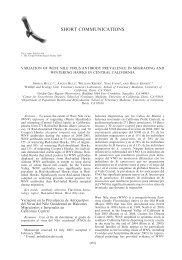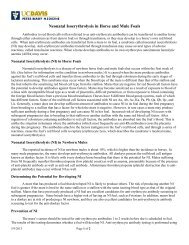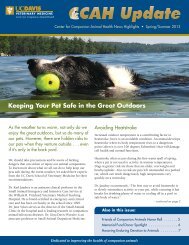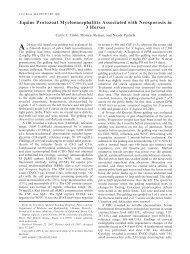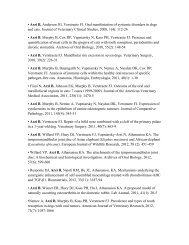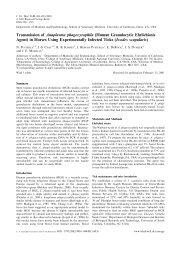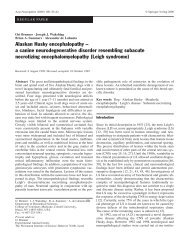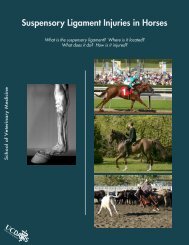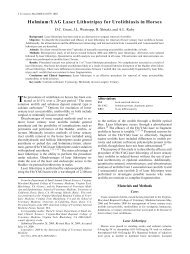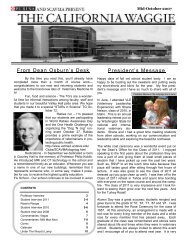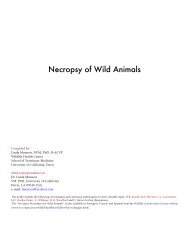Tabby - UC Davis School of Veterinary Medicine
Tabby - UC Davis School of Veterinary Medicine
Tabby - UC Davis School of Veterinary Medicine
You also want an ePaper? Increase the reach of your titles
YUMPU automatically turns print PDFs into web optimized ePapers that Google loves.
REPORTS<br />
1536<br />
tion involves a large displacement <strong>of</strong> H1, stabilized<br />
by new salt bridges with b-tubulin, and an<br />
opening <strong>of</strong> CC1 at the base <strong>of</strong> the stalk (Fig. 4E).<br />
The movements <strong>of</strong> H1 and CC1 likely constrain<br />
the registries that can be explored by the stalk,<br />
biasing the distribution toward the high-affinity<br />
a registry (Fig. 4E). Propagation <strong>of</strong> this signal to<br />
the head would elicit conformational changes<br />
that produce a movement <strong>of</strong> the linker domain<br />
and a displacement <strong>of</strong> dynein toward the MT<br />
minus end.<br />
Our analysis <strong>of</strong> dynamic salt bridges reveals<br />
that cytoplasmic dynein has been selected for<br />
submaximal processivity. Whereas kinesin has<br />
diversified its functional repertoire through gene<br />
duplication and divergence (33), cytoplasmic<br />
dynein is expressed from a single locus and<br />
may have evolved suboptimal processivity to increase<br />
the dynamic range <strong>of</strong> its regulation. High<br />
processivity could also be detrimental when multiple<br />
dyneins and kinesins must balance their<br />
actions on a single cargo (34). Consistent with<br />
this idea, intraflagellar dyneins, responsible for<br />
long, unidirectional transport within cilia (35, 36),<br />
contain neutral or basic residues at the equivalent<br />
<strong>of</strong> H6-E3378 (fig. S12), which would likely<br />
increase their processivity.<br />
References and Notes<br />
1. I. R. Gibbons, Cell Motil. Cytoskeleton 32, 136 (1995).<br />
2. P. Höök, R. B. Vallee, J. Cell Sci. 119, 4369 (2006).<br />
3. R. D. Vale, Cell 112, 467 (2003).<br />
4. R. B. Vallee, G. E. Seale, J.-W. Tsai, Trends Cell Biol. 19,<br />
347 (2009).<br />
5. R. B. Vallee, J. C. Williams, D. Varma, L. E. Barnhart,<br />
J. Neurobiol. 58, 189 (2004).<br />
6. S. A. Burgess, M. L. Walker, H. Sakakibara, P. J. Knight,<br />
K. Oiwa, Nature 421, 715 (2003).<br />
7. A. J. Roberts et al., Cell 136, 485 (2009).<br />
8. I. R. Gibbons, B. H. Gibbons, G. Mocz, D. J. Asai,<br />
Nature 352, 640 (1991).<br />
9. T. Kon, M. Nishiura, R. Ohkura, Y. Y. Toyoshima,<br />
K. Sutoh, Biochemistry 43, 11266 (2004).<br />
10. S. L. Reck-Peterson, R. D. Vale, Proc. Natl. Acad. Sci. U.S.A.<br />
101, 1491 (2004).<br />
11. S. L. Reck-Peterson et al., Cell 126, 335 (2006).<br />
12. T. Shima, T. Kon, K. Imamula, R. Ohkura, K. Sutoh,<br />
Proc. Natl. Acad. Sci. U.S.A. 103, 17736 (2006).<br />
13. A. P. Carter, C. Cho, L. Jin, R. D. Vale, Science 331, 1159<br />
(2011).<br />
14. T. Kon, K. Sutoh, G. Kurisu, Nat. Struct. Mol. Biol. 18,<br />
638 (2011).<br />
15. M. P. Koonce, J. Biol. Chem. 272, 19714 (1997).<br />
16. M. A. Gee, J. E. Heuser, R. B. Vallee, Nature 390, 636<br />
(1997).<br />
17. A. P. Carter et al., Science 322, 1691 (2008).<br />
18. I. R. Gibbons et al., J. Biol. Chem. 280, 23960 (2005).<br />
19. T. Kon et al., Nat. Struct. Mol. Biol. 16, 325 (2009).<br />
20. T. Kon et al., Nature 484, 345 (2012).<br />
21. N. Mizuno et al., EMBO J. 23, 2459 (2004).<br />
22. C.V.Sindelar,K.H.Downing,J. Cell Biol. 177, 377<br />
(2007).<br />
23. C. V. Sindelar, K. H. Downing, Proc. Natl. Acad. Sci. U.S.A.<br />
107, 4111 (2010).<br />
24. D. B. Wells, A. Aksimentiev, Biophys. J. 99, 629<br />
(2010).<br />
25. J. Löwe, H. Li, K. H. Downing, E. Nogales, J. Mol. Biol.<br />
313, 1045 (2001).<br />
26. L. G. Trabuco, E. Villa, K. Mitra, J. Frank, K. Schulten,<br />
Structure 16, 673 (2008).<br />
27. L. G. Trabuco, E. Villa, E. Schreiner, C. B. Harrison,<br />
K. Schulten, Methods 49, 174 (2009).<br />
28. J. Schlitter, M. Engels, P. Krüger, J. Mol. Graph. 12, 84<br />
(1994).<br />
29. S. Uchimura, Y. Oguchi, Y. Hachikubo, S. Ishiwata,<br />
E. Muto, EMBO J. 29, 1167 (2010).<br />
30. M. P. Koonce, I. Tikhonenko, Mol. Biol. Cell 11, 523<br />
(2000).<br />
31. Z. Wang, M. P. Sheetz, Biophys. J. 78, 1955 (2000).<br />
32. L.McNaughton,I.Tikhonenko,N.K.Banavali,D.M.LeMaster,<br />
M. P. Koonce, J. Biol. Chem. 285, 15994 (2010).<br />
33. E. M. Dagenbach, S. A. Endow, J. Cell Sci. 117, 3<br />
(2004).<br />
Specifying and Sustaining<br />
Pigmentation Patterns in Domestic<br />
and Wild Cats<br />
Christopher B. Kaelin, 1,2 * Xiao Xu, 3,4 * Lewis Z. Hong, 2 Victor A. David, 3 Kelly A. McGowan, 2<br />
Anne Schmidt-Küntzel, 3,5 Melody E. Roelke, 3,6 Javier Pino, 7 Joan Pontius, 3,6 Gregory M. Cooper, 1<br />
Hermogenes Manuel, 2 William F. Swanson, 8 Laurie Marker, 5 Cindy K. Harper, 9 Ann van Dyk, 10<br />
Bisong Yue, 4 James C. Mullikin, 11 Wesley C. Warren, 12 Eduardo Eizirik, 13,14 Lidia Kos, 7<br />
Stephen J. O’Brien, 3 †‡ Gregory S. Barsh, 1,2 † Marilyn Menotti-Raymond 3<br />
Color markings among felid species display both a remarkable diversity and a common underlying<br />
periodicity. A similar range <strong>of</strong> patterns in domestic cats suggests a conserved mechanism whose<br />
appearance can be altered by selection. We identified the gene responsible for tabby pattern variation<br />
in domestic cats as Transmembrane aminopeptidase Q (Taqpep), which encodes a membrane-bound<br />
metalloprotease. Analyzing 31 other felid species, we identified Taqpep as the cause <strong>of</strong> the rare king<br />
cheetah phenotype, in which spots coalesce into blotches and stripes. Histologic, genomic expression,<br />
and transgenic mouse studies indicate that paracrine expression <strong>of</strong> Endothelin3 (Edn3) coordinates<br />
localized color differences. We propose a two-stage model in which Taqpep helps to establish a periodic<br />
pre-pattern during skin development that is later implemented by differential expression <strong>of</strong> Edn3.<br />
The molecular basis and evolutionary variation<br />
<strong>of</strong> periodic mammalian color patterns<br />
have been difficult to investigate from<br />
genetic crosses <strong>of</strong> model organisms. Domestic cats<br />
(Felis catus) exhibit heritable variation <strong>of</strong> tabby<br />
markings—mackerel versus blotched—that pro-<br />
21 SEPTEMBER 2012 VOL 337 SCIENCE www.sciencemag.org<br />
34. M. A. Welte, Curr. Biol. 14, R525 (2004).<br />
35. C. Iomini, V. Babaev-Khaimov, M. Sassaroli, G. Piperno,<br />
J. Cell Biol. 153, 13 (2001).<br />
36. J. A. Laib, J. A. Marin, R. A. Bloodgood, W. H. Guilford,<br />
Proc. Natl. Acad. Sci. U.S.A. 106, 3190 (2009).<br />
Acknowledgments: We thank A. Carter (Laboratory <strong>of</strong><br />
Molecular Biology-Medical Research Council) for reagents and<br />
advice, C. Sindelar (Yale), V. Ramey [University <strong>of</strong> California<br />
(<strong>UC</strong>)–Berkeley], E. Egelman (University <strong>of</strong> Virginia), and<br />
R. Sinkovits (<strong>UC</strong>–San Diego) for sharing processing scripts<br />
and helpful advice; M. Sotomayor (Harvard) and R. Gaudet<br />
(Harvard) for advice concerning MD; J. Hogle (Harvard),<br />
M. Strauss (Harvard), and M. Wolf (Harvard) for help with film<br />
and the use <strong>of</strong> a film scanner; and E. Nogales (<strong>UC</strong>-Berkeley),<br />
N. Francis (Harvard), and D. Pellman (Harvard) for critically<br />
reading the manuscript, as well as all the members <strong>of</strong> the<br />
Leschziner and Reck-Peterson Labs for advice and helpful<br />
discussions. EM data were collected at the Center for<br />
Nanoscale Systems (CNS), a member <strong>of</strong> the National<br />
Nanotechnology Infrastructure Network (NNIN), which is<br />
supported by the National Science Foundation under NSF<br />
award no. ECS-0335765. CNS is part <strong>of</strong> Harvard University.<br />
MD simulations were run on the Odyssey cluster supported by<br />
the Faculty <strong>of</strong> Arts and Sciences Science Division Research<br />
Computing Group, Harvard University. S.L.R.-P. is funded by<br />
the Rita Allen Foundation, the Harvard Armenise Foundation,<br />
and an NIH New Innovator award (1 DP2 OD004268-1).<br />
A.E.L. was funded in part by a Research Fellowship from the<br />
Alfred P. Sloan Foundation. R.H.-L. was supported in part by<br />
Consejo Nacional de Ciencia y Tecnología and Fundación<br />
México en Harvard. The cryo-EM map was deposited at the<br />
EM Data Bank (EMDB-5439) and pseudo-atomic models at the<br />
Protein Data Bank (PDB-3J1T and -3J1U).<br />
Supplementary Materials<br />
www.sciencemag.org/cgi/content/full/337/6101/page/DC1<br />
Materials and Methods<br />
Figs. S1 to S12<br />
Tables S1 to S3<br />
References (37–53)<br />
Movies S1 to S6<br />
2 May 2012; accepted 20 July 2012<br />
10.1126/science.1224151<br />
vide an opportunity for such genetic analysis (1).<br />
<strong>Tabby</strong> markings are a composite <strong>of</strong> two features:<br />
(i) a light background component in which individual<br />
hairs have extensive light bands, and (ii)<br />
a superimposed darker component in which hairs<br />
have little or no banding. In mackerel cats, the<br />
dark component is organized into narrow vertical<br />
stripes with a constant and regular spacing, whereas<br />
in blotched cats, the dark component is expanded<br />
into a less organized structure with wide<br />
whorls (Fig. 1A). Periodic color patterns in other<br />
felids may represent the same process; for example,<br />
dark tabby markings in domestic cats may be<br />
homologous to black stripes or spots in tigers or<br />
cheetahs, respectively (2).<br />
A logical explanation for tabby patterning involves<br />
the Agouti-melanocortin receptor system,<br />
in which Agouti protein, a paracrine signaling<br />
molecule released from dermal papillae, acts on<br />
overlying hair follicle melanocytes to inhibit the<br />
melanocortin 1 receptor (Mc1r), causing a switch<br />
from the production <strong>of</strong> black/brown eumelanin to<br />
red/yellow pheomelanin (3, 4). According to this<br />
hypothesis, dark tabby stripes are areas in which<br />
Agouti signaling is suppressed or surmounted<br />
during hair growth and regeneration. However,<br />
known components <strong>of</strong> the Agouti-melanocortin<br />
EMBARGOED UNTIL 2PM U.S. EASTERN TIME ON THE THURSDAY BEFORE THIS DATE:
pathway do not affect the shape <strong>of</strong> tabby patterns<br />
(1, 2, 5, 6). Instead, the difference between mackerel<br />
and blotched is controlled by a single locus,<br />
<strong>Tabby</strong> (Ta), whose genetic position does not suggest<br />
an obvious candidate gene (7) but whose effects<br />
could be manifested via differential control<br />
<strong>of</strong> melanocortin signaling.<br />
The 3X cat genome assembly is not contiguous<br />
across the <strong>Tabby</strong> linkage interval (7), but<br />
comparison to homologous regions in the dog<br />
and human genomes suggests a candidate interval<strong>of</strong>~5Mbinlength(fig.S1A).OldWorldwild<br />
cats, from which domestic cats arose ~10,000 years<br />
ago (8), exhibit a mackerel-like pattern. However,<br />
the blotched pattern is common in many modern<br />
breeds, suggesting that one or a few Ta b causal<br />
variants would lie in a region <strong>of</strong> reduced allelic<br />
variation due to recent selection. We used comparative<br />
genomic information to identify singlenucleotide<br />
polymorphisms (SNPs) in the candidate<br />
interval, then genotyped and analyzed 16 blotched<br />
(Ta b /Ta b ) and 33 mackerel (Ta M /Ta M or Ta M /Ta b )<br />
animals from a feral population in northern California.<br />
Five SNPs from a 180-kb interval on chrA1<br />
showed significant association (P range = 9 × 10 −4<br />
to 3.2 × 10 −9 )(fig.S1B).<br />
Twenty-four markers genotyped in and around<br />
the associated region in 58 blotched and 19<br />
mackerel cats indicated that all blotched animals<br />
shared a common haplotype extending for 244 kb,<br />
whereas mackerel samples exhibited several haplotypes<br />
within the same interval (figs. S1C and<br />
S2). Coding sequences from three genes are located<br />
within the 244-kb interval: Commd10,<br />
LOC644100, and a third gene whose human<br />
ortholog has been referred to as both Aminopeptidase<br />
Q and Laeverin (9). No sequence alterations<br />
were observed in LOC644100 or Commd10, but<br />
most blotched cats carried a nonsense mutation,<br />
1<br />
HudsonAlpha Institute for Biotechnology, Huntsville, AL 35806,<br />
USA. 2 Department <strong>of</strong> Genetics, Stanford University, Stanford,<br />
CA, 94305, USA. 3 Laboratory <strong>of</strong> Genomic Diversity, Frederick<br />
National Laboratory for Cancer Research, Frederick, MD 21702,<br />
USA. 4 Sichuan Key Laboratory <strong>of</strong> Conservation Biology on<br />
Endangered Wildlife, College <strong>of</strong> Life Sciences, Sichuan<br />
University, Sichuan 610064, China. 5 Cheetah Conservation<br />
Fund, Post Office Box 1755, Otjiwarongo, Namibia. 6 SAIC-<br />
Frederick, Frederick National Laboratory for Cancer Research,<br />
Frederick, MD, 21702, USA. 7 Department <strong>of</strong> Biological Sciences,<br />
Florida International University, Miami, FL 33199, USA.<br />
8<br />
Center for Conservation and Research <strong>of</strong> Endangered Wildlife,<br />
Cincinnati Zoo & Botanical Garden, Cincinnati, OH 45220,<br />
USA. 9 <strong>Veterinary</strong> Genetics Laboratory, Faculty <strong>of</strong> <strong>Veterinary</strong><br />
Science Onderstepoort, University <strong>of</strong> Pretoria, Pretoria, South<br />
Africa. 10 The Ann van Dyk Cheetah Centre, De Wildt, South Africa.<br />
11<br />
Comparative Genomics Unit, National Human Genome Research<br />
Institute, National Institutes <strong>of</strong> Health, Rockville, MD<br />
20892, USA. 12 The Genome Center, Washington University in St.<br />
Louis, St. Louis, MO 63108, USA. 13 Faculdade de Biociências,<br />
Pontifícia Universidade Católica do Rio Grande do Sul, Porto<br />
Alegre, Rio Grande do Sul 90619-900, Brazil. 14 Instituto Pró-<br />
Carnívoros, Atibaia, Brazil.<br />
*These authors contributed equally to this work.<br />
†To whom correspondence and requests for materials should<br />
be addressed. E-mail: gbarsh@hudsonalpha.org (G.S.B.);<br />
lgdchief@gmail.com (S.J.O’B.).<br />
‡Present address: Theodosius Dobzhansky Center for Genome<br />
Informatics, St. Petersburg State University, St. Petersburg,<br />
Russia.<br />
W841X (Fig. 1B, fig. S2, and table S1), in exon 17<br />
<strong>of</strong> the third gene. We subsequently identified two<br />
additional variants in the same gene, S59X and<br />
A<br />
B<br />
Ta b mutant allele:<br />
Frequency:<br />
(non-breed cats)<br />
D228N (Fig. 1B, fig. S2, and table S1). This gene is<br />
expressed in developing felid skin, and its loss <strong>of</strong><br />
function causes a loss <strong>of</strong> color pattern periodicity<br />
Mackerel tabby (Ta M /Ta M or Ta M /Ta b ) Blotched (aka classic) tabby (Ta b /Ta b )<br />
Transmembrane Aminopeptidase Q (Taqpep)<br />
(exopeptidase, 380-384) (zinc binding, 416 - 439)<br />
1 SAMEN HEXXHX E 18<br />
990<br />
intracellular<br />
extracellular<br />
S59X (T139N) D228N W841X<br />
.04 .11 .02 .83<br />
Fig. 1. (A) Allelic variation at <strong>Tabby</strong> [mackerel (Ta M ) is dominant to blotched (Ta b )] controls the arrangement<br />
<strong>of</strong> dark- and light-colored areas. Diagrams indicate how the distribution <strong>of</strong> black or brown<br />
eumelanin versus yellow or pale pheomelanin within individual hairs underlies the macroscopic color<br />
patterns, although in reality cat hairs frequently exhibit multiple pheomelanic bands. (B) Taqpep encodes<br />
a type II membrane protein with aminopeptidase activity encoded by the ectodomain. Mutant allele<br />
frequencies are from a survey <strong>of</strong> 119 feral and outbred cats (table S1). The T139N allele is associated (P =<br />
0.0017, Fisher’s exact test) with an atypical swirled pattern but is incompletely penetrant (table S1 and<br />
fig. S2).<br />
A<br />
Spotted cheetah King cheetah<br />
Fig. 2. (A) Black-haired areas are larger, more irregular, and associated with dorsal stripes in the king<br />
cheetah. (B) Chromatogram <strong>of</strong> Taqpep cDNA from a spotted (+/+) as compared to a king (fs/fs) cheetah.<br />
EMBARGOED UNTIL 2PM U.S. EASTERN TIME ON THE THURSDAY BEFORE THIS DATE:<br />
REPORTS<br />
www.sciencemag.org SCIENCE VOL 337 21 SEPTEMBER 2012 1537
REPORTS<br />
1538<br />
without obvious effects on other organ systems. We<br />
refer to this gene as Transmembrane Aminopeptidase<br />
Q (Taqpep) and the protein product as Tabulin<br />
to reflect its organismal function.<br />
Taqpep encodes a type II membrane-spanning<br />
protein <strong>of</strong> the M1 aminopeptidase family, whose<br />
members are characterized by the presence <strong>of</strong><br />
GAMEN exopeptidase (SAMEN in Taqpep) and<br />
HEXXHX18E zinc-binding motifs in their extracellular<br />
domains (Fig. 1B) (9). In feral cats, we<br />
observed homozygosity or compound heterozygosity<br />
for the Ta b S59X or W841X alleles in 58<br />
out <strong>of</strong> 58 (58/58) blotched animals, with no<br />
phenotypic distinction among the different genotypic<br />
classes, compared to 51/51 mackerel cats<br />
that carried 0 or 1 Ta b alleles (table S1). A third<br />
Ta b allele, D228N, was found to cosegregate with<br />
the blotched phenotype in a research colony (fig.<br />
S2D). In feral cats, we also observed two variants<br />
at codon 139, one <strong>of</strong> which, T139N, was significantly<br />
associated (P = 0.0017, Fisher’s exact<br />
test) with an atypical swirled pattern (figs. S2 and<br />
S4D and table S1) and therefore may represent<br />
hypomorphic or neomorphic activity. Overall,<br />
the mutant W841X allele predominates and is<br />
responsible for the strong haplotype signature<br />
(fig. S1C), although the S59X allele occurs on<br />
the same haplotype background, in trans to<br />
W841X (fig. S2).<br />
Cheetahs (Acinonyx jubatus), with the rare<br />
king pattern were originally described as a distinct<br />
felid species (10) but were later recognized<br />
as having a monogenic trait with an autosomal<br />
recessive mode <strong>of</strong> inheritance (11). In king cheetahs,<br />
the black spots coalesce into larger areas,<br />
and multiple longitudinal black stripes appear<br />
on the dorsum (Fig. 2A). Wild king cheetahs<br />
have been sighted only in a small area <strong>of</strong> sub-<br />
Saharan Africa (fig. S3) (11). Taqpep genomic<br />
sequence from a captive king cheetah in North<br />
America revealed a base pair insertion in exon<br />
20, predicting a frameshift that replaces what<br />
would normally be the carboxy-terminal 16 amino<br />
acids with 109 new residues (N977Kfs110,<br />
Fig. 2B). Additional DNA samples from captive<br />
cheetahs in a large pedigree demonstrated complete<br />
cosegregation <strong>of</strong> the king pattern with the<br />
N977Kfs110 mutation [LOD (logarithm <strong>of</strong> odds)<br />
score = 5.7], and further revealed that the mutant<br />
allele was introduced into the pedigree by one<br />
homozygous and two heterozygous animals (fig.<br />
S3). We did not detect the N977Kfs110 mutation<br />
in wild cheetahs caught in Namibia (n = 191),<br />
Tanzania (n = 23), or Kenya (n =3).<br />
Depictions <strong>of</strong> tabby markings from the Middle<br />
Ages are mostly mackerel, but the blotched phenotype<br />
increased to a sufficiently high frequency<br />
to be described by Linnaeus in 1758 as characteristic<br />
for the domestic cat, predating the formation<br />
<strong>of</strong> most modern breeds. We examined the predicted<br />
Tabulin sequence in 351 cats from 24 breeds<br />
(table S2) and observed that the W841X allele is<br />
polymorphic in most breeds <strong>of</strong> Western origin, but<br />
rare or absent in Eastern breeds. The high allele<br />
frequency for W841X in Abyssinian (1.0), Birman<br />
(0.71), and Himalayan (0.77) cats is especially<br />
notable, because tabby markings in these breeds<br />
are masked by epistatic interactions. The S59X<br />
allele, probably representing a complete ablation <strong>of</strong><br />
protein function, is most common in Norwegian<br />
Forest Cats, and we observed one S59X/S59X<br />
homozygote with a blotched phenotype.<br />
We determined Taqpep sequence for 31 wild<br />
felid species, identifying 130 synonymous and<br />
64 nonsynonymous predicted substitutions (fig.<br />
S4A). We assessed the potential functional impact<br />
<strong>of</strong> the nonsynonymous substitutions with<br />
multivariate analysis <strong>of</strong> protein polymorphism<br />
(MAPP) (12), a quantitative approach that takes<br />
into account both evolutionary conservation and<br />
side-chain physicochemical properties. A MAPP<br />
score >10 indicates a likely impact on protein<br />
function, and the T139N and D228N substitutions<br />
associated with atypical swirled and blotched mutant<br />
phenotypes, respectively, in the domestic cat<br />
A B<br />
3 wks<br />
light<br />
5 wks<br />
7 wks<br />
dark<br />
yieldMAPPscores<strong>of</strong>11(P =1.5×10 −3 )and14<br />
(P =3.9×10 −4 ) (fig. S4B). In contrast, the T139A<br />
variant in the domestic cat (which does not affect<br />
pattern) yields a MAPP score <strong>of</strong> 3.8. The blackfooted<br />
cat (Felis nigripes) is a clear outlier from<br />
other Felidae, with five lineage-specific nonsynonymous<br />
substitutions and a combined MAPP<br />
score <strong>of</strong> 50 (fig. S4C). F. nigripes exhibits a spotting<br />
phenotype that is similar to the atypical swirled<br />
pattern associated with the T139N allele in domestic<br />
cats (fig. S4D); thus, recent evolution <strong>of</strong><br />
Taqpep in F. nigripes may contribute to its characteristic<br />
pattern.<br />
To investigate how color patterns are implemented,<br />
we examined fetal cat skin at 3, 5, and<br />
7 weeks <strong>of</strong> gestation, and observed that the first<br />
histologic indication <strong>of</strong> tabby markings coincides<br />
with their external appearance at 7 weeks, when<br />
follicle architecture is established and hair shafts<br />
begin to protrude through the epidermal surface<br />
light<br />
en face; epidermis up<br />
en face; dermis up<br />
dark<br />
Fig. 3. Skin sections <strong>of</strong> fetal cats [(A), at 3, 5, and 7 weeks <strong>of</strong> gestation] stained with hematoxylin and<br />
eosin, together with unstained flat-mount (en face) skin preparations <strong>of</strong> fetal cats [(B), at 7 weeks <strong>of</strong><br />
gestation]. The 7-week images in (B) are from an orange (O/Y or O/O) individual, which allows the dark<br />
component <strong>of</strong> the tabby pattern (which is orange-colored) to be more easily visualized. en face, xxxxxxx<br />
xxxxxx xxxxxx. In the trans-illuminated “dermis-up” panel, hair follicle outlines (dashed red lines)<br />
appear light-colored; melanin incorporation and blood vessels appear dark-colored. Scale bars in (A),<br />
150, 50, and 250 mm in 3-, 5-, and 7-week fetal cat sections, respectively, and 50 mm in the 7-week<br />
epidermis close-up. In (B), 2 mm, 100 mm, and 600 mm in epidermis-up, follicle histology, and dermisup<br />
panels, respectively.<br />
EMBARGOED UNTIL 2PM U.S. EASTERN TIME ON THE THURSDAY BEFORE THIS DATE:<br />
21 SEPTEMBER 2012 VOL 337 SCIENCE www.sciencemag.org
(Fig. 3). At this stage, the boundary between dark<br />
and light tabby components reflects differences<br />
in the amount <strong>of</strong> melanin deposition, with no<br />
apparent difference in cell type; melanocytes are<br />
present in both dark and light areas but produce<br />
more melanin in dark areas. Furthermore, the<br />
density and architecture <strong>of</strong> hair follicles are independent<br />
<strong>of</strong> localization to dark and light areas<br />
(Fig. 3B). This suggests that tabby markings arise<br />
from spatial variation in transcriptional activity<br />
rather than cell type distribution.<br />
We used the EDGE (EcoP15I-tagged Digital<br />
Gene Expression) (13) method for gene expression<br />
pr<strong>of</strong>iling to examine the transcriptome <strong>of</strong><br />
cheetah skin, in which there are sharp boundaries<br />
between black spots and the yellow interspot<br />
areas and for which multiple skin biopsies were<br />
Fig. 4. (A)Acheetahskinbiopsythat<br />
includes a black-yellow boundary (also<br />
seefig.S6).(B)EDGE(13) determination<br />
<strong>of</strong> differential gene expression in<br />
black- as compared to yellow-colored<br />
areas <strong>of</strong> cheetah skin. Transcript frequency<br />
(observations per million sequence<br />
reads, mean <strong>of</strong> five samples) is plotted<br />
as a function <strong>of</strong> differential expression.<br />
The 74 genes with significant differential<br />
expression are shown in black or<br />
yellow (FDR < 0.05, see materials and<br />
methods and tables S8 and S9); 7 additional<br />
pigmentation genes that are<br />
not differentially expressed are shown<br />
in pink. (C) Relative mRNA levels (mean T<br />
SE) for the indicated genes as assessed<br />
by qRT-PCR from paired samples (n =4)<br />
<strong>of</strong> dark and light neonatal tabby skin;<br />
*P < 0.05 (dark versus light, two-tailed t<br />
test). Dermal papilla expression <strong>of</strong> Edn3<br />
mRNA (purple stain, white arrows) as<br />
detected by in situ hybridization, from<br />
a brown tabby individual. The left panel<br />
illustrates the expression <strong>of</strong> Edn3 mRNA<br />
in both pheomelanin- and eumelanincontaining<br />
follicles. (D) Phenotypes <strong>of</strong><br />
2-week-old mice <strong>of</strong> the indicated genotypes.<br />
Relative mRNA levels (mean T<br />
SE) for the indicated genes from qRT-<br />
PCR <strong>of</strong> cDNA from control (n =4)and<br />
transgenic (n =4)miceareshown;*P <<br />
0.05 (A y versus A y ;Tg.K5-tTA;Tg.TRE-Edn3,<br />
two-tailed t test). Scale bars in (A), 40 and<br />
200 mmin epidermis and whole-skin sections,<br />
respectively. In (C), 60 and 20 mmin<br />
left and right panels, respectively.<br />
A<br />
available for study. Cheetah skin exhibits an unusual<br />
histologic architecture; the epidermis is<br />
heavily pigmented, and hair follicles are organized<br />
in clusters with extensive accessory structures<br />
(Fig. 4A and fig. S5A). However, the number<br />
and size <strong>of</strong> follicle clusters, as well as the number<br />
<strong>of</strong> epidermal pigment cells, do not vary between<br />
black-haired and yellow-haired areas (fig. S5B).<br />
Based on a previous analysis <strong>of</strong> EDGE results<br />
from a single cheetah, we hypothesized that black<br />
coloration involves localized alterations <strong>of</strong> genes<br />
downstream <strong>of</strong> Mc1r signaling (13). Biopsies <strong>of</strong><br />
yellow- and black-colored areas from five different<br />
animals enabled a genome-wide approach,<br />
in which the expression <strong>of</strong> 14,014 genes could<br />
be measured across a 10 6 -fold dynamic range<br />
(Fig. 4B). At a false discovery rate (q)
REPORTS<br />
1540<br />
crest derivatives, is a candidate for the coordination<br />
<strong>of</strong> spatial variation in hair color. A hypermorphic<br />
mutation <strong>of</strong> Gnaq, the second messenger through<br />
which Edn3 acts, causes the accumulation <strong>of</strong> dermal<br />
melanocytes during embryogenesis and converts<br />
yellow hair to black in postnatal mice (16, 17).<br />
Quantitative reverse transcription polymerase<br />
chain reaction (qRT-PCR) confirmed that the expression<br />
<strong>of</strong> Edn3 and Silv was increased in blackcolored<br />
as compared to yellow-colored areas <strong>of</strong><br />
cheetah skin; we also observed similar increases<br />
in a single leopard skin sample (fig. S5C). In<br />
neonatal skin from domestic cats (in which there<br />
is a high proportion <strong>of</strong> anagen follicles), Edn3<br />
mRNA expression was also ~tw<strong>of</strong>old higher in<br />
dark as compared to light areas (Fig. 4C), and in<br />
situ hybridization revealed that expression was<br />
restricted to the dermal papilla, a permanent portion<br />
<strong>of</strong> the hair follicle.<br />
In A y mutant mice, which express high levels<br />
<strong>of</strong> Agouti protein and produce pheomelanin instead<br />
<strong>of</strong> eumelanin, we confirmed that an Edn3<br />
transgene (18) converts yellow hair to dark brown–<br />
colored hair (Fig. 4D). Using qRT-PCR, we observed<br />
that the Edn3 transgene in mice also caused<br />
increased expression <strong>of</strong> the same melanocytespecific<br />
genes that are overexpressed in blackcolored<br />
areas <strong>of</strong> cheetah skin (Fig. 4B). Thus,<br />
increased expression <strong>of</strong> Edn3 in transgenic mice<br />
probably recapitulates both the coat color and<br />
A<br />
3-5 wks gestation<br />
epidermis<br />
+ Taqpep<br />
melanocytic gene expression phenotypes observed<br />
in cheetah skin, which suggests that localized<br />
expression <strong>of</strong> Edn3 during felid hair follicle growth<br />
serves as a master regulator <strong>of</strong> spatial hair color<br />
differences associated with tabby markings.<br />
In the skin <strong>of</strong> neonatal domestic cats and adult<br />
cheetahs, Taqpep mRNA is expressed at low<br />
levels that do not differ between dark and light<br />
areas (Fig. 4, B and C). In mice, levels <strong>of</strong> wholeembryo<br />
Taqpep mRNA as measured by qRT-PCR<br />
increased progressively during gestation and were<br />
highest in postnatal skin (fig. S6). In situ hybridization<br />
to mouse embryos (at embryonic days 10.5<br />
to 17.5) and to fetal cat skin at 3, 5, 6, and 7 weeks<br />
<strong>of</strong> gestation did not reveal localization <strong>of</strong> Taqpep<br />
mRNA to any specific cell type or region.<br />
Because tabby markings are apparent soon<br />
after the time when melanocytes enter hair follicles<br />
(Fig. 3A), the effects <strong>of</strong> Taqpep on pattern<br />
morphology must occur at or before follicle development<br />
and are therefore likely to be mediated<br />
by epithelial or mesenchymal cells. Our results<br />
suggest that Taqpep is required to establish the<br />
periodicity <strong>of</strong> tabby markings during skin development<br />
(Fig. 5A), and that the “tabby marking”<br />
identity <strong>of</strong> a particular region is implemented and<br />
maintained by the ability <strong>of</strong> dermal papilla cells to<br />
sustain high versus low levels <strong>of</strong> Edn3 production<br />
throughout subsequent hair cycles (Fig. 5B). This<br />
model also helps to explain why, in contrast to many<br />
Establishment <strong>of</strong> pre-pattern during fetal skin development<br />
keratinocytes<br />
dermis melanoblasts<br />
B<br />
- Taqpep<br />
7-8 wks gestation<br />
Implementation <strong>of</strong> pattern during follicle growth/regeneration<br />
Edn3: low high<br />
hair follicle<br />
melanocytes<br />
dermal<br />
papilla<br />
Fig. 5. A tabby pre-pattern is established at or before hair follicle development (A), specifying regions as<br />
dark (gray-colored) or light (yellow-colored). In the absence <strong>of</strong> Taqpep, dark regions are expanded, and<br />
there is less periodicity. Regional identity is manifested and implemented (B) by differential expression <strong>of</strong><br />
Edn3 in the dermal papilla, a permanent part <strong>of</strong> the hair follicle that releases paracrine factors to act on<br />
overlying melanocytes. Yellow and black pigment are synthesized by melanocytes in hair follicles that<br />
produce low and high levels <strong>of</strong> Edn3, respectively.<br />
21 SEPTEMBER 2012 VOL 337 SCIENCE www.sciencemag.org<br />
periodic color patterns in fish, which are mediated<br />
by and depend on direct contact between pigment<br />
cells (19–21), tabby markings change in size but<br />
not number during organismal growth.<br />
Our findings also provide a mechanistic explanation<br />
for epistasis relationships between Agouti,<br />
Mc1r, and<strong>Tabby</strong>. Homozygosity for a loss-<strong>of</strong>function<br />
Agouti allele is associated with a “ghost<br />
pattern” in which <strong>Tabby</strong> stripes are difficult or impossible<br />
to visualize, because eumelanogenic genes<br />
such as Tyr, Tyrp1, Dct,andPmel are already upregulated.<br />
The ghost pattern becomes apparent,<br />
however, in animals that are doubly mutant for<br />
Agouti and Mc1r (5), because endothelin and<br />
melanocortin signaling act in parallel (fig. S7).<br />
A system in which distinct paracrine signaling<br />
pathways—endothelins via a Gaq-coupled receptor<br />
and melanocortins via a Gas-coupled receptor—<br />
converge on overlapping cellular machinery could<br />
explain more complicated phenotypes, in which<br />
pheomelanin-rich yellow versus eumelanin-rich<br />
black areas exhibit both periodic and regional<br />
fluctuation, such as spots or stripes <strong>of</strong> alternative<br />
pigment types overlaid on a background <strong>of</strong> dorsoventral<br />
differences, as is apparent in leopards,<br />
jaguars, and tigers. Further studies <strong>of</strong> color pattern<br />
in domestic-wild cat hybrids <strong>of</strong>fer the opportunity<br />
to study these complex color markings and<br />
add to our knowledge <strong>of</strong> how felids acquire their<br />
color patterns.<br />
References and Notes<br />
1. T. D. Lomax, R. Robinson, J. Hered. 79, 21 (1988).<br />
2. A. G. Searle, Comparative Genetics <strong>of</strong> Coat Color in<br />
Mammals (Academic Press, New York, 1968).<br />
3. S. E. Millar, M. W. Miller, M. E. Stevens, G. S. Barsh,<br />
Development 121, 3223 (1995).<br />
4. I. J. Jackson, Annu. Rev. Genet. 28, 189 (1994).<br />
5. M. Peterschmitt, F. Grain, B. Arnaud, G. Deléage,<br />
V. Lambert, Anim. Genet. 40, 547 (2009).<br />
6. E. Eizirik et al., Curr. Biol. 13, 448 (2003).<br />
7. E. Eizirik et al., Genetics 184, 267 (2010).<br />
8. C. A. Driscoll et al., Science 317, 519 (2007).<br />
9. M. Maruyama et al., J. Biol. Chem. 282, 20088 (2007).<br />
10. R. I. Pocock, Proc. Zool. Soc. London 97, 245 (1927).<br />
11. R. J. van Aarde, A. van Dyk, J. Zool. 209, 573 (1986).<br />
12. E. A. Stone, A. Sidow, Genome Res. 15, 978 (2005).<br />
13. L. Z. Hong, J. Li, A. Schmidt-Küntzel, W. C. Warren,<br />
G. S. Barsh, Genome Res. 21, 1905 (2011).<br />
14. C. S. April, G. S. Barsh, Pigment Cell Res. 19, 194 (2006).<br />
15. T. Kobayashi et al., J. Cell Sci. 108, 2301 (1995).<br />
16. C. D. Van Raamsdonk, K. R. Fitch, H. Fuchs, M. H. de<br />
Angelis, G. S. Barsh, Nat. Genet. 36, 961 (2004).<br />
17. C. D. Van Raamsdonk, G. S. Barsh, K. Wakamatsu, S. Ito,<br />
Pigment Cell Melanoma Res. 22, 819 (2009).<br />
18. R. J. Garcia et al., J. Invest. Dermatol. 128, 131 (2008).<br />
19. A. Nakamasu, G. Takahashi, A. Kanbe, S. Kondo,<br />
Proc. Natl. Acad. Sci. U.S.A. 106, 8429 (2009).<br />
20. M. Iwashita et al., PLoS Genet. 2, e197 (2006).<br />
21. M. Watanabe et al., EMBO Rep. 7, 893 (2006).<br />
Acknowledgments: We thank San Jose Animal Care and<br />
Services, Fix Our Ferals, the Berkeley East-Bay Humane Society,<br />
Pets In Need, the Monterey Animal Hospital, and the City <strong>of</strong><br />
Huntsville Animal Shelter for assistance with sample collection;<br />
the Wild Cat Education and Conservation Fund for contributing<br />
king cheetah samples; R. Finn for assistance with Norwegian<br />
Forest Cat samples and phenotypes; H. Flick for domestic cat<br />
photographs; and J. C. Kaelin for help with feral cat sample<br />
collection. We thank the Production Sequencing Group <strong>of</strong> the<br />
Washington University <strong>School</strong> <strong>of</strong> <strong>Medicine</strong> Genome Center for<br />
cDNA Sequencing. Namibian samples were collected with the<br />
approval <strong>of</strong> the Ministry <strong>of</strong> Environment and Tourism (permit<br />
EMBARGOED UNTIL 2PM U.S. EASTERN TIME ON THE THURSDAY BEFORE THIS DATE:
1532). Supported in part by the HudsonAlpha Institute for<br />
Biotechnology and by the Intramural Research Program <strong>of</strong> the<br />
NIH, National Cancer Institute, Center for Cancer Research,<br />
using federal funds under contract N01-CO-12400. L.Z.H. and<br />
J.P. were supported by fellowships from Genentech and the<br />
National Institutes <strong>of</strong> Health, respectively. A.vD. is the founder<br />
and director <strong>of</strong> the Ann van Dyk Cheetah Centre, a nonpr<strong>of</strong>it<br />
conservation organization. DNA sequence data for this study are<br />
available at http://genome.wustl.edu/genomes/view/felis_catus/<br />
and the NIH Short Read Archive (SRA056885).<br />
Supplementary Materials<br />
www.sciencemag.org/cgi/content/full/337/6101/[page]/DC1<br />
Materials and Methods<br />
Loss <strong>of</strong> the Tumor Suppressor BAP1<br />
Causes Myeloid Transformation<br />
Anwesha Dey, 1 Dhaya Seshasayee, 2 Rajkumar Noubade, 2 Dorothy M. French, 3 Jinfeng Liu, 4<br />
Mira S. Chaurushiya, 1 Donald S. Kirkpatrick, 5 Victoria C. Pham, 5 Jennie R. Lill, 5<br />
Corey E. Bakalarski, 4 Jiansheng Wu, 5 Lilian Phu, 5 Paula Katavolos, 6 Lindsay M. LaFave, 7<br />
Omar Abdel-Wahab, 7 Zora Modrusan, 8 Somasekar Seshagiri, 8 Ken Dong, 9 Zhonghua Lin, 10<br />
Mercedesz Balazs, 10 Rowena Suriben, 1 Kim Newton, 1 Sarah Hymowitz, 9<br />
Guillermo Garcia-Manero, 11 Flavius Martin, 2 Ross L. Levine, 7 Vishva M. Dixit 1 *<br />
De-ubiquitinating enzyme BAP1 is mutated in a hereditary cancer syndrome with increased risk<br />
<strong>of</strong> mesothelioma and uveal melanoma. Somatic BAP1 mutations occur in various malignancies.<br />
We show that mouse Bap1 gene deletion is lethal during embryogenesis, but systemic or<br />
hematopoietic-restricted deletion in adults recapitulates features <strong>of</strong> human myelodysplastic<br />
syndrome (MDS). Knockin mice expressing BAP1 with a 3xFlag tag revealed that BAP1 interacts<br />
with host cell factor–1 (HCF-1), O-linked N-acetylglucosamine transferase (OGT), and the polycomb<br />
group proteins ASXL1 and ASXL2 in vivo. OGT and HCF-1 levels were decreased by Bap1 deletion,<br />
indicating a critical role for BAP1 in stabilizing these epigenetic regulators. Human ASXL1 is<br />
mutated frequently in chronic myelomonocytic leukemia (CMML) so an ASXL/BAP1 complex may<br />
suppress CMML. A BAP1 catalytic mutation found in a MDS patient implies that BAP1 loss <strong>of</strong><br />
function has similar consequences in mice and humans.<br />
Somatic inactivating BAP1 mutations occur<br />
in the majority <strong>of</strong> metastatic uveal melanomas<br />
and approximately one-quarter <strong>of</strong><br />
malignant pleural mesotheliomas. Somatic mutations<br />
also have been identified in breast, lung,<br />
and renal cell cancers (1–5). Recently, germline<br />
BAP1 mutations were linked to a tumor predisposition<br />
syndrome characterized by melanocytic<br />
tumors, mesothelioma, and uveal melanoma<br />
(6, 7).<br />
We investigated the normal physiological<br />
role <strong>of</strong> BAP1 using BAP1-deficient mice (fig.<br />
S1A). Bap1 −/− embryos showed developmen-<br />
1<br />
Department <strong>of</strong> Physiological Chemistry, Genentech, 1 DNA<br />
Way, South San Francisco, CA 94080, USA. 2 Department <strong>of</strong><br />
Immunology, Genentech, 1 DNA Way, South San Francisco,<br />
CA 94080, USA. 3 Department <strong>of</strong> Pathology, Genentech, 1<br />
DNA Way, South San Francisco, CA 94080, USA. 4 Department<br />
<strong>of</strong> Bioinformatics and Computational Biology, Genentech, 1<br />
DNA Way, South San Francisco, CA 94080, USA. 5 Department<br />
<strong>of</strong> Protein Chemistry, Genentech, 1 DNA Way, South San<br />
Francisco, CA 94080, USA. 6 Department <strong>of</strong> Safety Assessment,<br />
Genentech, 1 DNA Way, South San Francisco, CA 94080, USA.<br />
7<br />
Human Oncology and Pathogenesis Program and Leukemia<br />
Service, Memorial Sloan Kettering Cancer Center, 1275 York<br />
Avenue, New York, NY 10065, USA. 8 Department <strong>of</strong> Molecular<br />
Biology, Genentech, 1 DNA Way, South San Francisco, CA<br />
94080, USA. 9 Department <strong>of</strong> Structural Biology, Genentech, 1<br />
DNA Way, South San Francisco, CA 94080, USA. 10 Department<br />
<strong>of</strong>TranslationalImmunology,Genentech,1DNAWay,South<br />
San Francisco, CA 94080, USA. 11 MD Anderson Cancer Center,<br />
1515 Holcombe Boulevard, Houston, TX 77030, USA.<br />
*To whom correspondence should be addressed. E-mail:<br />
dixit@gene.com<br />
tal retardation at embryonic day 8.5 (E8.5) and<br />
were not detected beyond E9.5, indicating that<br />
BAP1 is essential for embryo development (fig.<br />
S1, B and C). To bypass this embryonic lethality,<br />
we bred mice that expressed the tamoxifeninducible<br />
recombinase creERT2 ubiquitously<br />
from the Rosa26 locus (8) and had Bap1 exons<br />
4and5flankedbyloxsites(floxed)(fig.S1A).<br />
The floxed Bap1 exons were deleted from most<br />
adult mouse tissues at 1 week after daily tamoxifen<br />
injections for 5 days were completed,<br />
the brain being the expected exception (fig.<br />
S1D). Loss <strong>of</strong> Bap1 mRNA from hematopoietic<br />
lineages at 1 week after the final tamoxifen injection<br />
was confirmed by quantitative reverse<br />
transcription polymerase chain reaction (fig.<br />
S1E), and BAP1 protein was no longer detected<br />
in splenocytes by Western blotting (fig. S1F).<br />
Within 4 weeks <strong>of</strong> the last tamoxifen injection,<br />
100% <strong>of</strong> the Bap1 fl/fl creERT2 + mice [hereafter<br />
referred to as BAP1 knockout (BAP1 KO) mice]<br />
developed splenomegaly (n = 12 mice). This<br />
phenotype was never observed in Bap1 +/+<br />
creERT2 + control mice [hereafter referred to as<br />
wild-type (WT) mice] (Fig. 1, A and B). Histopathology,<br />
flow cytometry, and myeloperoxidase<br />
immunohistochemistry revealed that splenomegaly<br />
in the KO mice resulted from extramedullary<br />
hematopoiesis and expansion <strong>of</strong> the myeloid<br />
lineage (Fig. 1, C to E). Myeloid cells also were<br />
increased in lymph nodes (fig. S2) and bone<br />
marrow (Fig. 1F).<br />
Supplementary Text<br />
Tables S1 to S9<br />
Figs. S1 to S7<br />
References (22–36)<br />
22 February 2012; accepted 20 July 2012<br />
10.1126/science.1220893<br />
Peripheral blood taken from 11 out <strong>of</strong> 12 BAP1<br />
KO mice at 4 weeks after the final tamoxifen injection<br />
showed cytological features consistent with<br />
myelodysplasia and ineffective erythropoiesis (Fig.<br />
1G). Total leukocyte numbers were elevated (Fig.<br />
1H) because <strong>of</strong> monocytosis (Fig. 1I) and neutrophilia<br />
(Fig. 1J), which is consistent with chronic<br />
myelomonocytic leukemia (CMML)–like disease<br />
[classified as a myelodysplastic/myeloproliferative<br />
disease according to the new World Health Organization<br />
classification <strong>of</strong> myeloid neoplasms<br />
(9)]. Thrombocytopenia was detected as early as<br />
1 week after the final tamoxifen injection (Fig.<br />
1K), and all diseased mice developed severe progressive<br />
anemia (Fig. 1L). We noted morphologic<br />
features <strong>of</strong> erythroid dysplasia, including increased<br />
numbers <strong>of</strong> nucleated red blood cells, anisopoikilocytosis,<br />
and prominent basophilic stippling<br />
(Fig. 1L). Hypersegmented neutrophils (Fig. 1J),<br />
bilobed granulocytes (Fig. 1I), giant platelets (Fig.<br />
1K), hyposegmented neutrophils consistent with<br />
pseudo-Pelger-Huët anomaly, and atypical immature<br />
cells with myelomonocytic features were<br />
also observed. Mitotic figures and apoptotic cells<br />
(fig. S3) were consistent with human myelodysplastic<br />
syndrome (MDS) (10), whereas blasts<br />
were rare. Collectively, these data show that<br />
Bap1 deletion produces a myeloproliferative/<br />
myelodysplastic disorder with features <strong>of</strong> human<br />
CMML. Consistent with what is seen in patients<br />
with end-organ damage from myeloid neoplasms,<br />
the BAP1 KO heart contained microthrombi<br />
with multifocal necrosis, neutrophilic inflammation,<br />
and infiltration <strong>of</strong> myeloblastic cells (fig. S4).<br />
Given that chronic myeloid neoplasms originate<br />
in the phenotypic hematopoietic stem cell<br />
(HSC) compartment (11), we characterized the<br />
lineage-depleted hematopoietic progenitor cell population<br />
in the BAP1 KO mice. Lineage-negative<br />
ScaI – c-Kit + myeloid progenitor cells and HSCenriched<br />
lineage-negative ScaI + c-Kit + (LSK) cells<br />
wereincreasedinBAP1KOspleenandbonemarrow<br />
as early as 2 weeks after the final tamoxifen<br />
injection (fig. S5A). Given that BAP1 KO mice<br />
develop monocytosis and neutrophilia, BAP1 KO<br />
LSK cells harvested 1 month after tamoxifen treatment<br />
expressed higher levels <strong>of</strong> a subset <strong>of</strong> genes<br />
involved in myelopoiesis [fig. S5, B and C (12)].<br />
In methylcellulose colony-forming assays, BAP1<br />
KO LSK cells yielded fewer colonies than WT<br />
LSK cells (fig. S6, A and B). In addition, unlike<br />
cells from WT colonies, which could be replated<br />
after 10 days in culture to form new colonies, replated<br />
BAP1 KO cells did not produce wellformed<br />
colonies, and many exhibited cytoplasmic<br />
blebbing characteristic <strong>of</strong> apoptosis (fig. S6, C<br />
and D). These in vitro data suggest that BAP1<br />
EMBARGOED UNTIL 2PM U.S. EASTERN TIME ON THE THURSDAY BEFORE THIS DATE:<br />
REPORTS<br />
www.sciencemag.org SCIENCE VOL 337 21 SEPTEMBER 2012 1541



